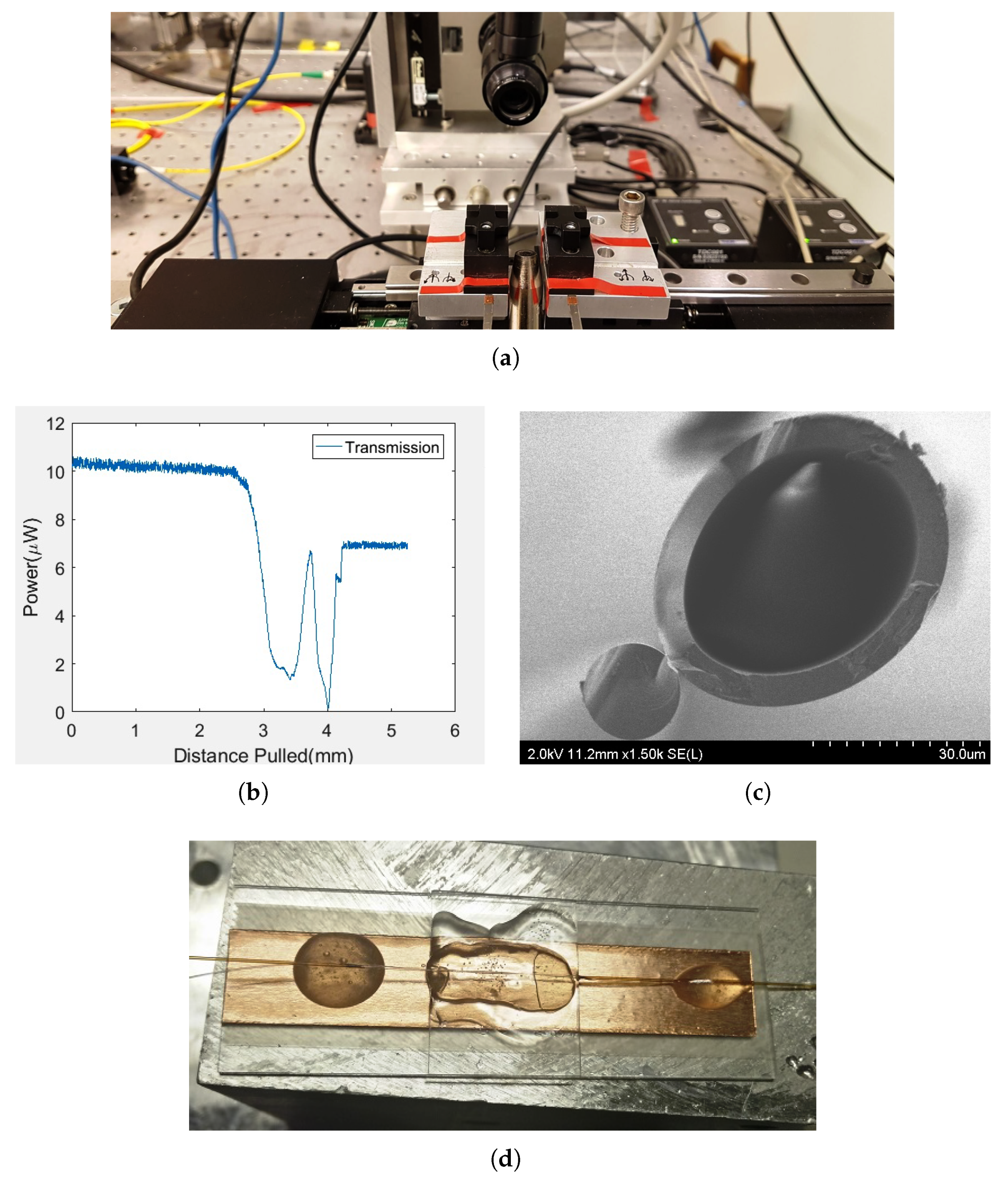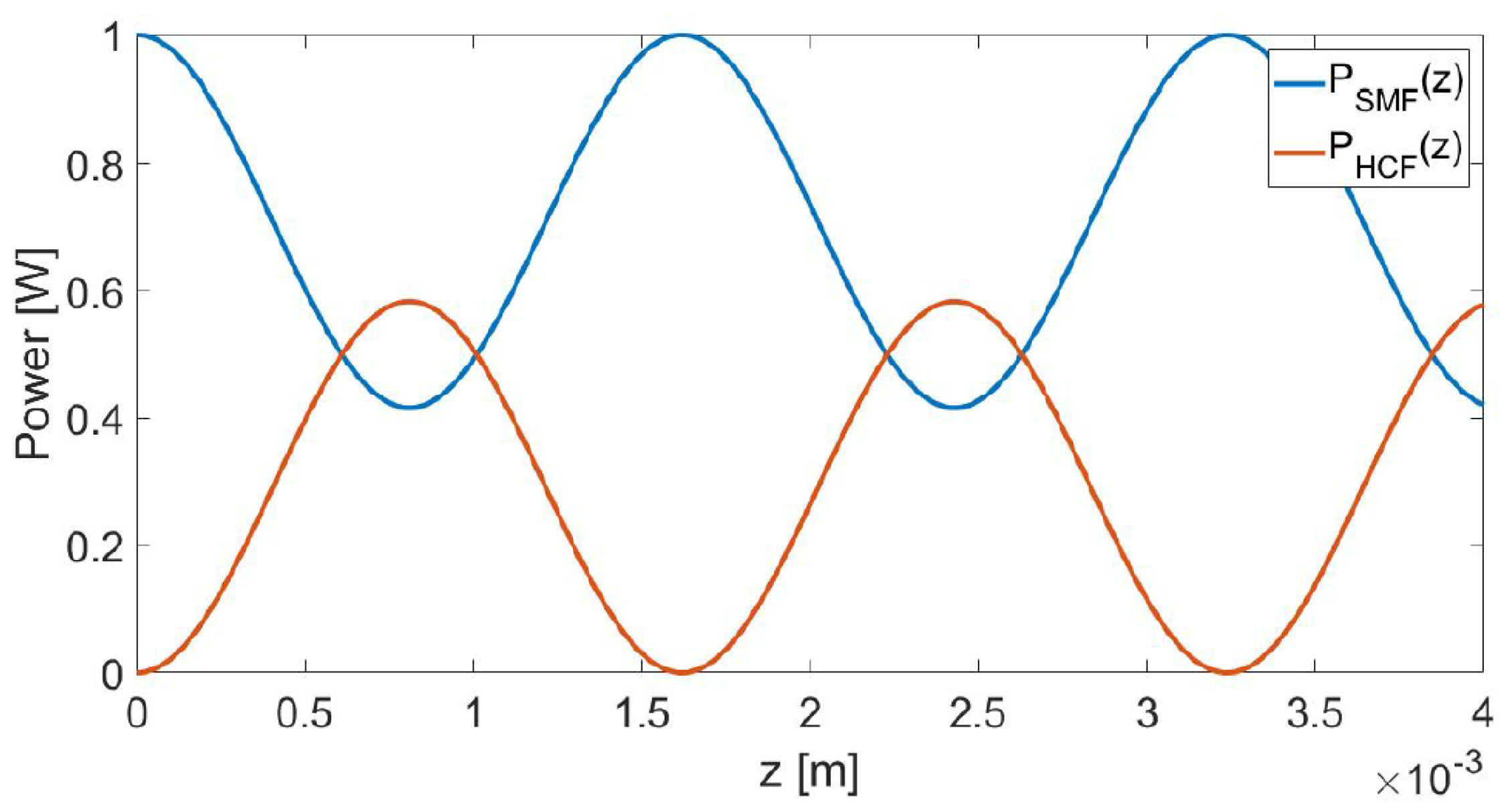Hollow Fiber Coupler Sensor
Abstract
:1. Introduction
2. Results
Experiment and Outcome
3. Materials and Methods
4. Discussion
5. Conclusions
Author Contributions
Funding
Acknowledgments
Conflicts of Interest
Abbreviations
| SCF | Solid core fiber |
| HCF | Hollow core fiber |
| RI | Refractive index |
References
- Kersey, A.D. A review of recent developments in fiber optic sensor technology. Opt. Fiber Technol. 1996, 2, 291–317. [Google Scholar] [CrossRef]
- Poloso, T. Fibre bragg gratings optical sensing technology. Smart Mater. Bull. 2001, 2001, 7–10. [Google Scholar] [CrossRef]
- Lee, B. Review of the present status of optical fiber sensors. Opt. Fiber Technol. 2003, 9, 57–79. [Google Scholar] [CrossRef]
- Grattan, K.T.V.; Sun, T. Fiber optic sensor technology: An overview. Sens. Actuators A Phys. 2000, 82, 40–61. [Google Scholar] [CrossRef]
- Pinto, A.M.R.; Lopez-Amo, M. Photonic crystal fibers for sensing applications. J. Sens. 2012, 2012, 598178. [Google Scholar] [CrossRef]
- Yeo, T.L.; Sun, T.; Grattan, K.T.V. Fiber-optic sensor technologies for humidity and moisture measurement. Sens. Actuators A Phys. 2008, 144, 280–295. [Google Scholar] [CrossRef]
- Koohyar, F. Refractive index and its applications. J. Thermodyn. Catal. 2013, 4, e117. [Google Scholar] [CrossRef]
- Pereira, D.A.; Frazao, O.; Santos, J.L. Fibre Bragg grating sensing system for simultaneous measurement of salinity and temperature. Opt. Eng. 2004, 43, 299–304. [Google Scholar] [CrossRef]
- Magwaza, L.S.; Opara, U.L. Analytical methods for determination of sugars and sweetness of horticultural products—A review. Sci. Hortic. 2015, 184, 179–192. [Google Scholar] [CrossRef]
- Katsoulos, P.D.; Athanasiou, L.V.; Karatzia, M.A.; Giadinis, N.; Karatzias, H.; Boscos, C.; Polizopoulou, Z.S. Comparison of biuret and refractometry methods for the serum total proteins measurement in ruminants. Vet. Clin. Pathol. 2017, 46, 620–624. [Google Scholar] [CrossRef] [PubMed]
- Sutton, R.H. The refractometric determination of the total protein concentration in some animal species. N. Z. Vet. J. 1976, 24, 141–148. [Google Scholar] [CrossRef] [PubMed]
- Bianchetti, A.; Federico, A.; Vincent, S.; Subramanian, S.; Vollmer, F. Refractometry-based air pressure sensing using glass microspheres as high-Q whispering-gallery mode microresonators. Opt. Commun. 2017, 394, 152–156. [Google Scholar] [CrossRef]
- Homola, J.; Čtyroký, J.; Skalský, M.; Hradilová, J.; Kolářová, P. A Surface plasmon resonance based integrated optical sensor. Sens. Actuators B Chem. 1997, 39, 286–290. [Google Scholar] [CrossRef]
- Liu, Q.; Chiang, K.S. Refractive-index sensor based on long-range surface plasmon mode excitation with long-period waveguide grating. Opt. Exp. 2009, 17, 7933–7942. [Google Scholar] [CrossRef]
- Mishra, S.K.; Zou, B.; Chiang, K.S. Surface-plasmon-resonance refractive-index sensor with cu-coated polymer waveguide. IEEE Photonics Technol. Lett. 2016, 28, 1835–1838. [Google Scholar] [CrossRef]
- Meltz, G.; Hewlett, S.J.; Love, J.D. Fiber grating evanescent-wave sensors. SPIE Proc. 1996, 2836, 342. [Google Scholar]
- Asseh, A.; Sandgren, S.; Ahlfeldt, H.; Sahlgren, B.; Stubbe, R.; Edwall, G. Fiber optical bragg grating refractometer. Fiber Integr. Opt. 1998, 17, 51–62. [Google Scholar]
- Zhou, K.; Chen, X.; Zhang, L.; Bennion, I. High-sensitivity optical chemsensor based on etched D-fibre bragg gratings. Electron. Lett. 2004, 40, 232–234. [Google Scholar] [CrossRef]
- Liang, W.; Huang, Y.; Xu, Y.; Lee, R.K.; Yariv, A. Highly sensitive fiber bragg grating refractive index sensors. Appl. Phys. Lett. 2005, 86, 151122. [Google Scholar] [CrossRef]
- Bhatia, V.; Vengsarkar, A.M. Optical fiber long-period grating sensors. Opt. Lett. 1996, 21, 692–694. [Google Scholar] [CrossRef]
- Rees, N.D.; James, S.W.; Tatam, R.P.; Ashwell, G.J. Optical fiber long-period gratings with Langmuir blodgett thin-film overlays. Opt. Lett. 2002, 27, 686–688. [Google Scholar] [CrossRef] [PubMed]
- Hu, H.; Du, C.; Wang, Q.; Wang, X.; Zhao, Y. High sensitivity internal refractive index sensor based on a photonic crystal fiber long period grating. Instrum. Sci. Technol. 2017, 45, 181–189. [Google Scholar] [CrossRef]
- Rindorf, L.; Bang, O. Highly sensitive refractometer with a photonic-crystal-fiber long-period grating. Opt. Lett. 2008, 33, 563–565. [Google Scholar] [CrossRef] [PubMed]
- Tazawa, H.; Kanie, T.; Katayama, M. Fiber-optic coupler based refractive index sensor and its application to biosensing. Appl. Phys. Lett. 2007, 91, 113901. [Google Scholar] [CrossRef]
- Wu, D.K.C.; Kuhlmey, B.T.; Eggleton, B.J. Ultrasensitive photonic crystal fiber refractive index sensor. Opt. Lett. 2009, 34, 322–324. [Google Scholar] [CrossRef]
- Wu, D.K.C.; Lee, K.J.; Pureur, V.; Kuhlmey, B.T. Performance of refractive index sensors based on directional couplers in photonic crystal fibers. J. Lightwave Technol. 1986, 31, 3500–3510. [Google Scholar] [CrossRef]
- Chen, J.C.; Ho, C.W.; Wang, J.S. Optical Fiber coupler with a hollow core fiber for magnetic fluid detection. J. Lightwave Technol. 2012, 34, 5220–5225. [Google Scholar] [CrossRef]
- Qu, H.; Skorobogatiy, M. Liquid-core low-refractive-index-contrast Bragg fiber sensor. Appl. Phys. Lett. 2011, 98, 201114. [Google Scholar] [CrossRef] [Green Version]
- Zheng, K.; Shang, L. High-Linearity refractive index sensor based on analyte-filled defect hollow core bragg fiber. IEEE Photonics Technol. Lett. 2017, 29, 1391–1394. [Google Scholar] [CrossRef]
- Zhao, Y.; Li, X.G.; Cai, L.; Zhang, Y.N. Measurement of RI and temperature using composite interferometer with hollow-core fiber and photonic crystal fiber. IEEE Trans. Instrum. Meas. 2016, 65, 2631–2635. [Google Scholar] [CrossRef]
- Donlagic, D.; Cibula, E. All-fiber high-sensitivity pressure sensor with SiO2 diaphragm. Opt. Express 2005, 30, 2071–2073. [Google Scholar]
- Choi, H.Y.; Mudhana, G.; Park, K.S.; Paek, U.C.; Lee, B.H. Cross-talk free and ultra-compact fiber optic sensor for simultaneous measurement of temperature and refractive index. Opt. Express 2010, 18, 141–149. [Google Scholar] [CrossRef] [PubMed]
- Özel, B.; Nett, R.; Weigel, T.; Schweiger, G.; Ostendorf, A. Temperature sensing by using whispering gallery modes with hollow core fibers. Meas. Sci. Technol. 2010, 21, 1–5. [Google Scholar] [CrossRef]
- Zhao, Y.; Tong, R.; Chen, M.; Xia, F. Fluorescence temperature sensor based on gqds solution encapsulated in hollow core fiber. IEEE Photonics Technol. Lett. 2017, 29, 1544–1547. [Google Scholar] [CrossRef]
- Ghatak, A.; Thyagarajan, K. Introduction to fIber Optics; Cambridge University Press: Cambridge, UK, 1997. [Google Scholar]
- Liang, L.; Jin, L.; Ran, Y.; Sun, L.; Guan, B. Interferometric detection of microRNAs using a capillary optofluidic sensor. Sens. Actuators B Chem. 2017, 242, 999–1006. [Google Scholar] [CrossRef]
- Polymicro Technologies. Polyimide Coated Fused Silica Capillary Tubing; TSP320450 Datasheet; Polymicro Technologies: Phoenix, AZ, USA, 2016. [Google Scholar]
- Kim, K.T.; Park, K.H. Fiber-optic temperature sensor based on single mode fused fiber coupler. J. Opt. Soc. Korea 2008, 12, 152–156. [Google Scholar] [CrossRef]
- Du, X.; Vincent, S.; Faucher, M.; Picard, M.J.; Lu, T. Generalized full-vector multi-mode matching analysis of whispering gallery microcavities. Opt. Express 2014, 22, 13507–13514. [Google Scholar] [CrossRef] [PubMed]
- Du, X.; Vincent, S.; Lu, T. Full-vectorial whispering-gallery-mode cavity analysis. Opt. Express 2013, 21, 22012–22022. [Google Scholar] [CrossRef]




© 2019 by the authors. Licensee MDPI, Basel, Switzerland. This article is an open access article distributed under the terms and conditions of the Creative Commons Attribution (CC BY) license (http://creativecommons.org/licenses/by/4.0/).
Share and Cite
Kuruba, N.; Lu, T. Hollow Fiber Coupler Sensor. Sensors 2019, 19, 806. https://doi.org/10.3390/s19040806
Kuruba N, Lu T. Hollow Fiber Coupler Sensor. Sensors. 2019; 19(4):806. https://doi.org/10.3390/s19040806
Chicago/Turabian StyleKuruba, Nithin, and Tao Lu. 2019. "Hollow Fiber Coupler Sensor" Sensors 19, no. 4: 806. https://doi.org/10.3390/s19040806



